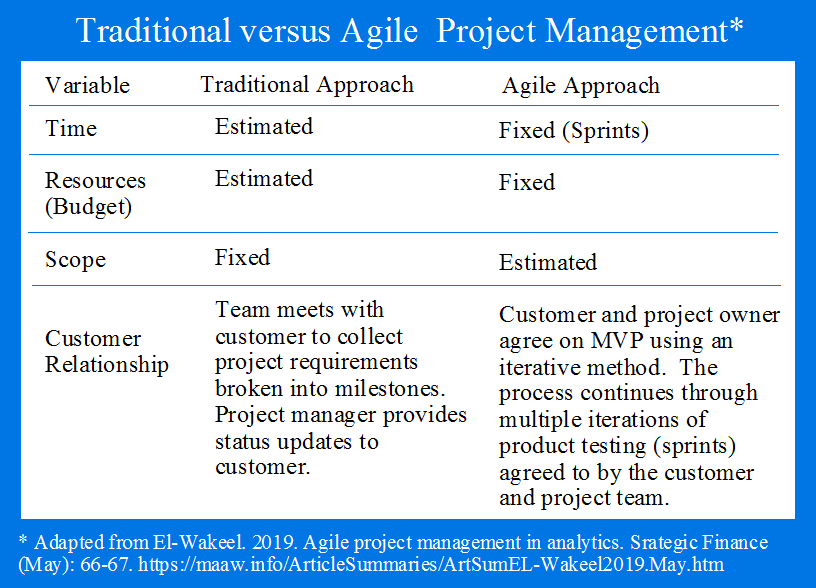
Summary by James R. Martin, Ph.D., CMA
Professor Emeritus, University of South Florida
Project Management Main Page |
Teams and Teamwork Main Page
The purpose of this article is to provide an introduction to agile project management including some definitions and a brief example.
The Three Main Variables
The three main variables in project management are time, resources, and scope. In traditional project management, time and resources are estimated, and the scope of the project is fixed. In agile project management time and resources are fixed, while the scope of the project is estimated.
The Traditional Project Management Model
The traditional project management model includes a project manager and a team of specialist. The team meets with the customer (internal or external) to establish the project requirements that are broken into parts called milestones. The project manager is responsible for keeping the customer up to date on the status of the project. However, since the scope of the project is fixed, changes in the business environment that might influence the project are likely to be ignored. The traditional approach is also vulnerable to other problems such as delays, miscalculations and unexpected costs.
The Agile Project Management Model
The agile project management approach involves multiple meetings with the customer. Initially, the project owner and customer meet and agree on a minimal viable product (MVP) using an iterative method. This continues with multiple interations of product testing aligned to the customer's needs. The time for each MVP is referred to as a sprint and each sprint is based on a plan (agreed to by the team and customer) to complete the work. When each sprint is completed the team meets with the customer to provide and receive feedback.

Some Agile Terminology
Scrums - Regular team meetings to review progress.
Scrum Master - Oversees the project development and keeps everyone on track.
A Scrum of Scrums - Meetings with multiple teams working on related projects.
Sprint - time to complete a minimum viable product (MVP)
Backlog - list of tasks that need to be completed by the team.
Product Owner - Reviews the needs of stakeholders and manages the backlog.
Agile Project Management Example
The example involves a customer who has a reporting problem related to pricing. The initial MVP is a dashboard with key performance indicators (KPIs). Sprint 2 involves creating more KPIs. At the end of sprint 2, discussions with the customer reveal a need for more visibility related to pricing. The team proposes developing a pricing optimizaiton model for the customer that is completely different from the original project. This becomes the MVP for sprint 3. The team delivers, and although this is not what the customer thought he needed, the customer is happy with the outcome. If the traditional project approach had been used, the customer would not have received what he really needed.
_________________________________________
Related summaries:
Rigby, D. K., J. Sutherland and H. Takeuchi. 2016. Embracing agile: How to master the process that's transforming management. Harvard Business Review (May): 40-50. (Summary).
Scott, T. W. and P. Tiessen. 1999. Performance measurement and managerial teams. Accounting, Organizations and Society 24(3): 263-285. (Summary).
Spear, S. J. 2004. Learning to lead at Toyota. Harvard Business Review (May): 78-86. (Summary).
Spear, S. and H. K. Bowen. 1999. Decoding the DNA of the Toyota production system. Harvard Business Review (September-October): 97-106. (Summary).
Staats, B. R. and D. M. Upton. 2011. Lean knowledge work: The "Toyota" principles can also be effective in operations involving judgment and expertise. Harvard Business Review (October): 100-110. (Summary).
Swank, C. K. 2003. The lean service machine. Harvard Business Review (October): 123-129. (Summary).